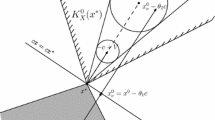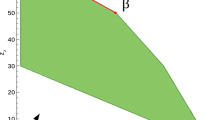Abstract
The problems of (bi-)proportional rounding of a nonnegative vector or matrix, resp., are written as particular separable convex integer minimization problems. Allowing any convex (separable) objective function we use the notions of vector and matrix apportionment problems. As a broader class of problems we consider separable convex integer minimization under linear equality restrictions Ax = b with any totally unimodular coefficient matrix A. By the total unimodularity Fenchel duality applies, despite the integer restrictions of the variables. The biproportional algorithm of Balinski and Demange (Math Program 45:193–210, 1989) is generalized and derives from the dual optimization problem. Also, a primal augmentation algorithm is stated. Finally, for the smaller class of matrix apportionment problems we discuss the alternating scaling algorithm, which is a discrete variant of the well-known Iterative Proportional Fitting procedure.
Similar content being viewed by others
References
Balinski ML and Demange G (1989). Algorithms for proportional matrices in reals and integers. Math Program 45: 193–210
Balinski ML and Rachev ST (1997). Rounding proportions: methods of rounding. Math Scientist 22: 1–26
Balinski M (2006) Apportionment: uni- and bi-dimensional. In: Simeone B, Pukelsheim F (eds) Mathematics and democracy—recent advances in voting systems and collectice choice. Berlin, pp 43–54
Bazaraa MS, Sherali HD and Shetty CM (1993). Nonlinear programming—theory and algorithms, 2nd edn. Wiley, New York
Berge C (1991). Graphs third revised edition. Elsevier, New York
De Loera J, Hemmecke R, Onn S, Weismantel R (2006) N-fold integer programming. e-print available on http:ArXiv:math.OC/0605242, 2006
Dorfleitner G and Klein T (1999). Rounding with multiplier methods: an efficient algorithm and applications in statistics. Stat Pap 40: 143–157
Fourer R (1985). A simplex algorithm for piecewise-linear programming I: derivation and proof. Math Program 33: 204–233
Gaffke N, Pukelsheim F (2007) Divisor methods for proportional representation systems: an optimization approach to vector and matrix apportionment problems (submitted)
Graver JE (1975). On the foundations of linear and integer linear programming. Math Program 8: 207–226
Happacher M and Pukelsheim F (1996). Rounding probabilities: unbiased multipliers. Stat Decis 14: 373–382
Happacher M and Pukelsheim F (2000). Rounding probabilities: maximum probability and minimum complexity multipliers. J Stat Plan Inference 85: 145–158
Hemmecke R (2003) Test sets for integer programs with \({\mathbb{Z}}\) -convex objective. Typescript, UC Davis. e-print available from http://front.math.ucdavis.edu/math.CO/0309154, 2003
Hochbaum DS and Shanthikumar JG (1990). Convex separable optimization is not much harder that linear optimization. J Assoc Comput Machinery 37: 843–862
Murota K, Saito H and Weismantel R (2004). Optimality criterion for a class of nonlinear integer programs. Oper Res Lett 32: 468–472
Rockafellar RT (1972). Convex Analysis. Princeton University Press, Princeton
Rote G, Zachariasen M (2007) Matrix scaling by network flow. In: Proceedings of the eighteenth annual ACM-SIAM symposium on discrete algorithms. Proceedings in Applied Mathematics, vol 125. Philadelphia, PA, 2007, pp 848–854
Saaty TL (1970). Optimization in integers and related extremal problems. McGraw-Hill, New York
Schrijver A (1999). Theory of linear and integer programming. Wiley, New York
Schulz A, Weismantel R (1999) An oracle-polynomial time augmentation algorithm for integer programming. In: Proc. of the 10th ACM-SIAM symposium on discrete algorithms. Baltimore, 1999, pp 967–968
Sturmfels B and Thomas RR (1997). Variation of cost functions in integer programming. Math Program 77: 357–387
Sun J, Tsai K-H and Qi L (1993). A simplex method for network programs with convex separable piecewise linear costs and its applications to stochastic transshipment problems. In: Du, DZ and Pardalos, PM (eds) Network optimization problems, pp. World Scientific Publications, Singapore
Te Riele HJJ (1978). The proportional representation problem in the Second Chamber: an approach via minimal distances. Stat Neerlandica 32: 163–179
Thépot J (1986). Scrutin proportionnel et optimization mathématique (in French). R.A.I.R.O. 20: 123–138
Author information
Authors and Affiliations
Corresponding author
Rights and permissions
About this article
Cite this article
Gaffke, N., Pukelsheim, F. Vector and matrix apportionment problems and separable convex integer optimization. Math Meth Oper Res 67, 133–159 (2008). https://doi.org/10.1007/s00186-007-0184-7
Received:
Revised:
Published:
Issue Date:
DOI: https://doi.org/10.1007/s00186-007-0184-7




